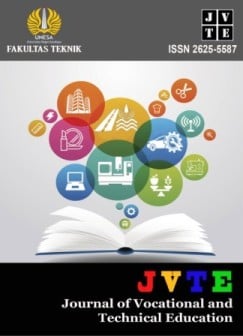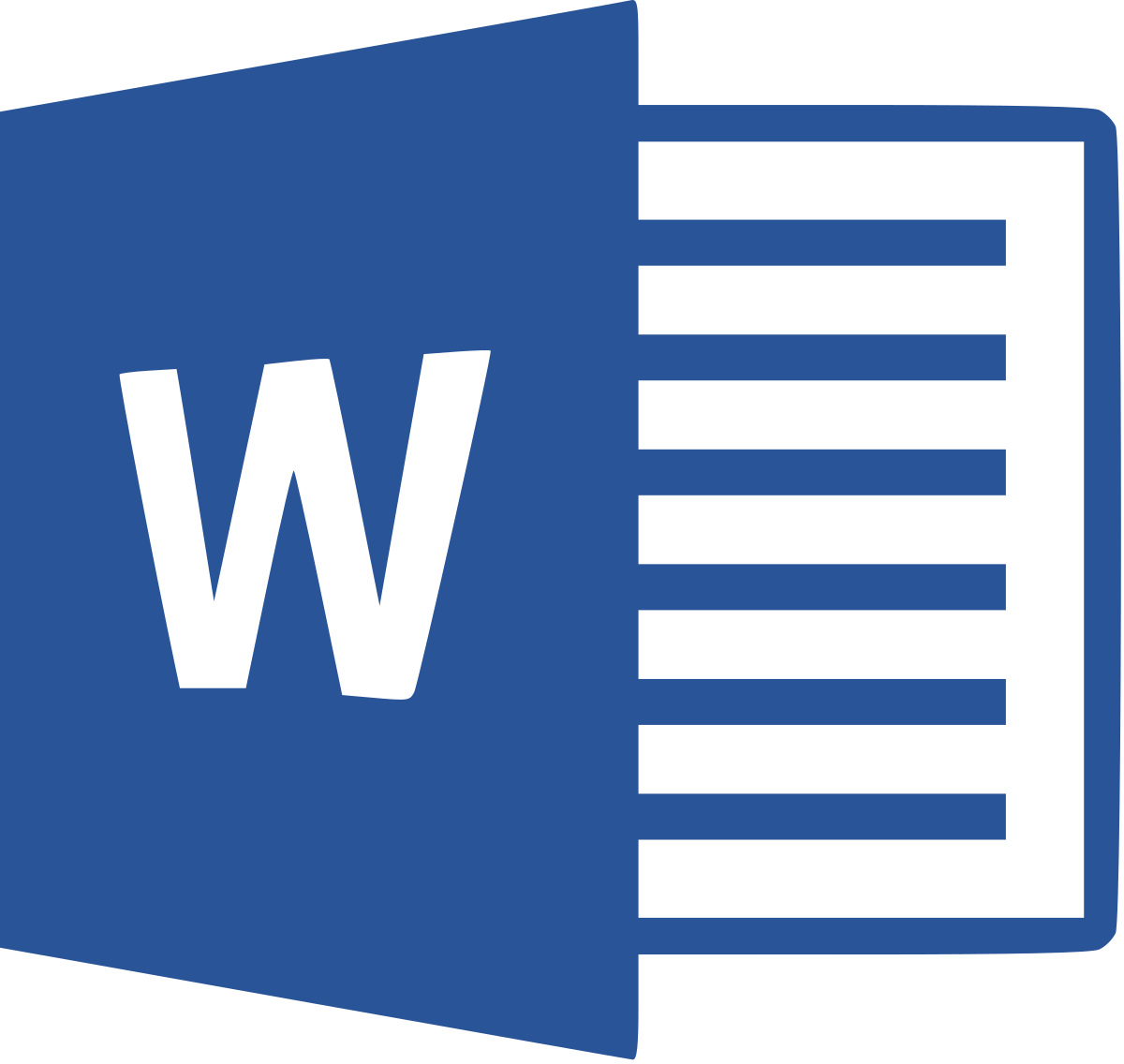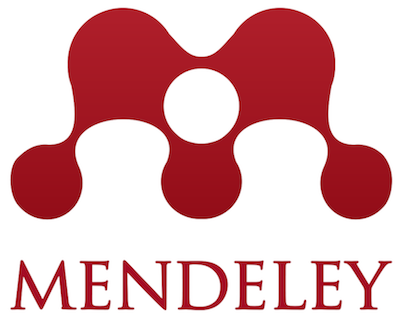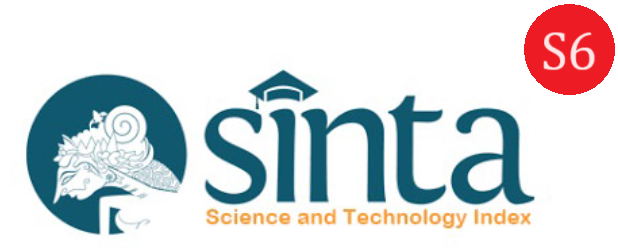PELUANG DAN TANTANGAN PENDIDIKAN VOKASIONAL MENGHADAPI ERA REVOLUSI INDUSTRI 4.0
DOI:
https://doi.org/10.26740/jvte.v7n1.p39-48Keywords:
Revolusi Industri 4.0, Peluang dan Tantangan, Pendidikan VokasionalAbstract
Era Revolusi Industri 4.0 merupakan globalisasi dimana sistem manufaktur virtual dan fisik secara global saling berintegrasi dengan cara yang fleksibel yang memungkinkan kostumisasi produk dan penciptaan model operasi baru, dengan adanya cyber physical systems dan Internet of Things yang merupakan sistem cerdas dan komunikatif temasuk komunikasi mesin-ke-mesin dan interaksi manusia-mesin. Dengan berbagai kemudahan teknologi yang ditawarkan saat ini, disadari atau tidak akan berdampak pada berbagai sektor kehidupan, terutama dalam era disrupsi. Sektor pendidikan pun terkena imbas dari era Revolusi Industri 4.0 khususnya pendidikan vokasi. Tak dapat dipungkiri, pendidikan merupakan investasi penting bagi manusia dan aset berharga bagi kemajuan negara. Peluang pendidikan vokasi dalam era Revolusi Industri 4.0 utamanya adalah kesempatan bagi semua pihak untuk mencetak generasi unggul yang mampu menghadapi segala perubahan yang terjadi di masa mendatang. Tantangan pendidikan vokasi menghadapi era Revolusi Industri meliputi perubahan dari cara belajar, pola pikir, serta pola bertindak para peserta didik dalam mengembangkan inovasi kreatif berbagai bidang, kemampuan berpikir orde tinggi (High order thinking skills / HOTS), soft skills dan adanya tuntutan kualifikasi dan skill yang diperlukan pada era Revolusi Industri 4.0 yaitu knowledge about ICT, kemampuan bekerja dengan data, technical know-how, dan personal skills.
References
[1] Avis, J. (2018). Socio-Technical Imaginary of The Fourth Industrial Revolution and Its Implications for Voca-tional Education and Training: A Literature Review. Journal of Vocational Education & Training. https://doi.org/https://doi.org/10.1080/13636820.2018.1498907
[2] Bal, H. C., & Erkan, C. (2019). Industry 4.0 and Competitiveness. Elsevier: Procedia Computer Science, 625–631. https://doi.org/10.1016/j.procs.2019.09.096
[3] Barber, M., Donnelly, K., & Rizvi, S. (2013). An Avalanche Is Coming. Higher Education and the Revolution Ahead. London UK: Institute for Public Policy Research.
[4] Benešová, A., & Tupa, J. (2017). Requirements for Education and Qualification of People in Industry 4.0. Elsevier: Procedia Manufacturing. https://doi.org/doi: 10.1016/j.promfg.2017.07.366
[5] Bruri, M. T. (2015). The Indicators of Instructional Design for E- learning in Indonesian Vocational High Schools. Elsevier: Procedia Social and Behavioral Sciences. https://doi.org/doi: 10.1016/j.sbspro.2015.08.109
[6] Bruri, M. T. (2017). Tantangan Revolusi Industri ke 4 (I4.0) bagi Pendidikan Vokasi. Seminar Nasional Vokasi Dan Teknologi (SEMNASVOKTEK).
[7] Brynjolfsson, E., & A. McAfee. (2014). The Second Machine Age: Work, Progress and Prosperity in a Time of Brilliant Technologies. New York: Norton & Company.
[8] Christensen, C. M. (1997). The Innovator’s Dilemma: When New Technologies Cause Great Firms to Fail. Boston MA: Harvard Business School Press.
[9] Daugherty, R., & Wilson, H. (2018). Human + Machine: Reimagining Work in the Age of AI. Boston: Har-vard business Review Press.
[10] Dean, M., & Spoehr, J. (2018). The fourth industrial revolution and the future of manufacturing work in Aus-tralia: challenges and opportunities. Taylor & Francis: Labour & Industry. https://doi.org/https://doi.org/10.1080/10301763.2018.1502644
[11] Dengler, K., & Matthes, B. (2015). Folgen der Digitalisierung für die Arbeitswelt: Substituierbarkeitspoten-ziale von Berufen in Deutschland (Konsekuensi digitalisasi untuk dunia kerja: Potensi untuk penggantian profesi di Jerman). IAB-Forschungsbericht 11/2015, 34. Retrieved from http://doku.iab.de/forschungsbericht/2015/fb1115.pdf
[12] Depdiknas. (2003). Undang-Undang Nomor 20 tahun 2003 tentang Sistem Pendidikan Nasional. Retrieved from https://www.unpad.ac.id/wp-content/uploads/2012/10/UU20-2003-Sisdiknas.pdf
[13] European Commission. (2016). A new skills agenda for Europe: Communication from the commission to the European parliament, the council, the European economic and social committee and the committee of the re-gions. Retrieved from https://ec.europa.eu/transparency/regdoc/rep/1/2016/EN/1-2016-381-EN-F1-1.PDF
[14] Evans, R. N., & Edwin, L. H. (1978). Foundation of Vocational Education. Columbus Ohio: Charles E. Mer-ril Publishing Company.
[15] Federal Ministry of Labour and Social Affairs. (2017). Work 4.0 (white paper). Retrieved from https://www.bmas.de/SharedDocs/Downloads/EN/PDF-Publikationen/a883-white-paper.pdf;jsessionid=ECB50387CB90862FAFB4558FDA434860?__blob=publicationFile&v=3
[16] Galloway, J. D., Wenrich, J. W., & Wenrich, R. C. (1988). Administration of Vocational Education. Amer Technical Pub.
[17] Ghobakhloo, M. (2019). Digitization, and Opportunities for Sustainability. Elsevier: Journal of Cleaner Pro-duction. https://doi.org/https://doi.org/10.1016/j.jclepro.2019.119869
[18] Gilchrist, A. (2016). Industry 4.0: The Industrial Internet of Things. New York: Springer: Apress Media.
[19] Greinert, W. D. (1988). Marktmodell-Schulmodell-Duales system. Grundtypen formalisierter Berufsbildung [Market model – school model – dual system. The basic models of formal TVET]. Die Berufsbildende Schule (Vol. 40, Pp. 145–156).
[20] Harkins, A. M. (2008). Leapfrog Principles and Practices: Core Components of Education 3.0 and 4.0. Fu-tures Research Quarterly Draft VII.
[21] Jung, J. (2019). The Fourth Industrial Revolution, Knowledge Production and Higher Education in South Ko-rea. Taylor & Francis: Journal of Higher Education Policy and Management. https://doi.org/ttps://doi.org/10.1080/1360080X.2019.1660047
[22] Khasali, R. (2018). Strawberry Generation. Jakarta: Mizan.
[23] Kurt, R. (2019). Industry 4.0 in Terms of Industrial Relations and Its Impacts on Labour Life. Elsevier: Pro-cedia Computer Science. https://doi.org/10.1016/j.procs.2019.09.093
[24] Marope, P. T. M., Chakroun, B., & Holmes, K. P. (2015). Unleashing the potential. Transforming technical and vocational education and training. Paris: UNESCO.
[25] Pannen, P. (2018). Mempersiapkan SDM Indonesia di Era Industri 4.0. Kemenristekdikti, 1–22.
[26] Pavlova, M. (2009). Technology and Vocational Education for Sustainable Developmen, Empowering Indi-viduals for the Future. Bonn: Springer.
[27] Peters, M. A. (2017). Technological unemployment: Educating for the fourth industrial revolution. Taylor & Francis: Educational Philosophy and Theory. https://doi.org/https://doi.org/10.1080/00131857.2016.1177412
[28] Popkova, E. G., Ragulina, Y. V, & Bogoviz, A. V. (2019). Industry 4.0: Industrial Revolution of the 21st Cen-tury. Switzerland: Springer International Publishing.
[29] Prasetyo, B., & Trisyanti, U. (2018). Revolusi Industri 4.0 Dan Tantangan Perubahan Sosial. IPTEK Journal of Proceedings Series, 0(5), 22–27. https://doi.org/10.12962/j23546026.y2018i5.4417
[30] Prosser, C. A., & Quigle, T. H. (1968). Vocational Education in a Democracy. USA: Longman.
[31] Schröder, T. (2019). A Regional Approach for The Development of TVET Systems in Th
[32] e Light of The 4th Industrial Revolution: The Regional Association of Vocational and Technical Education in Asia. Taylor & Francis Group: International Journal of Training Research. https://doi.org/https://doi.org/10.1080/14480220.2019.1629728
[33] Schwab, K. (2016). The Fourth Industrial Revolution. Switzerland: World Economy Forum.
[34] Schwab, K. (2017). The Fourth Industrial Revolution. London UK: Penguin Books.
[35] Sofyan, H. (2011). Optimalisasi pembelajaran berbasis kompetensi pada pendidikan kejuruan. Jurnal Pen-didikan Vokasi, 1(1), 113. https://doi.org/10.21831/jpv.v1i1.5805
[36] Sofyan, H. (2019). Materi Kuliah Organisasi Manajemen PTK: ORG&MANJ PTK Mg 1-2019 (p. 30). p. 30. Yogyakarta: UNY.
[37] Sofyan, H., Pardjono, Djatmiko, I., & Sudira, P. (2013). Paradigma Baru Pendidikan Vokasi. Yogyakarta: UNY Press.
[38] Spöttl, G., Gordl, C., Windelband, L., Grantz, T., & Richter, T. (2016). Studie Industrie 4.0— Auswirkungen auf die Aus- und Weiterbildung in der M+E Industrie [study industry 4.0 – effects on initial and further voca-tional education and training in the mechanical and electrical industry]. Retrieved from https://www.baymevbm.de/Redaktion/Frei-zugaengliche-Medien%0A/Abteilungen-GS/Bildung/2016/Downloads/baymevbm_Studie_Industrie-4-0.pdf
[39] Sudira, P. (2017). TVET Abad XXI Filosofi, Teori, Konsep, dan Strategi Pembelajaran Vokasional (1st ed.). Yogyakarta: UNY Press.
[40] Sudira, P. (2018). Metodologi Pembelajaran Vokasional Abad XXI: Inovasi, Teori, dan Praksis. Yogyakarta: UNY Press.
[41] Suharno, Pambudi, N. A., & Harjanto, B. (2020). Vocational education in Indonesia: History, development, opportunities, and challenges. Elsevier: Children and Youth Services Review. https://doi.org/https://doi.org/10.1016/j.childyouth.2020.105092
[42] Sutarto, H. P. (2017). Desain Pengembangan Kurikulum Pendidikan Vokasi: Perspektif Internasional & Na-sional. Yogyakarta: UNY Press.
[43] Sutherland, E. (2019). The Fourth Industrial
[44] Revolution – The Case of South Africa. Taylor & Francis: Politikon. https://doi.org/https://doi.org/10.1080/02589346.2019.1696003
[45] UBS. (2016). Extreme automation and connectivity: The global, regional, and investment implications of the Fourth Industrial Revolution. In UBS White Paper for the World Economic Forum Annual Meeting 2016. Da-vos: World Economic Forum.
[46] Ustundag, A., & Cevikcan, E. (2018). Industry 4.0: Managing The Digital Transformation. In Springer Series in Advanced Manufacturing. Retrieved from http://link.springer.com/10.1007/978-3-319-57870-5%0Ahttp://www.springer.com/series/7113
[47] Wagner, T. (2008). The global achievement gap. New York: Basic Books.
[48] Wardiman. (1998). Pengembangan Sumber Daya Manusia melalui Sekolah Menengah Kejuruan. Jakarta: PT Jayakarta Agung Offset.
[49] Yusnaini, & Slamet. (2019). Era Revolusi Industri 4.0: Tantangan dan Peluang dalam Upaya Meningkatkan Literasi Pendidikan. Prosiding Seminar Nasional Pendidikan Program Pascasarjana Universitas Pgri Palem-bang, 2, 1073–1085. Retrieved from https://jurnal.univpgri-palembang.ac.id/index.php/Prosidingpps/article/view/2668
Downloads
Published
How to Cite
Issue
Section
License

This work is licensed under a Creative Commons Attribution-NonCommercial-ShareAlike 4.0 International License.
 Abstract views: 712
,
Abstract views: 712
, PDF Downloads: 634
PDF Downloads: 634






